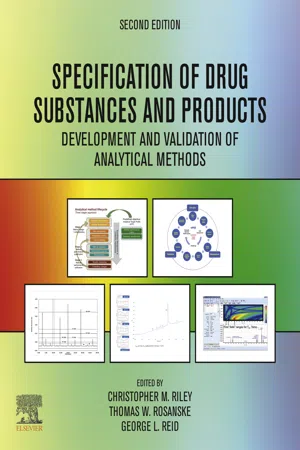
Specification of Drug Substances and Products
Development and Validation of Analytical Methods
- 694 pages
- English
- ePUB (mobile friendly)
- Available on iOS & Android
Specification of Drug Substances and Products
Development and Validation of Analytical Methods
About This Book
Specification of Drug Substances and Products: Development and Validation of Analytical Methods, Second Edition, presents a comprehensive and critical analysis of the requirements and approaches to setting specifications for new pharmaceutical products, with an emphasis on phase-appropriate development, validation of analytical methods, and their application in practice. This thoroughly revised second edition covers topics not covered or not substantially covered in the first edition, including method development and validation in the clinical phase, method transfer, process analytical technology, analytical life cycle management, special challenges with generic drugs, genotoxic impurities, topical products, nasal sprays and inhalation products, and biotechnology products.
The book's authors have been carefully selected as former members of the ICH Expert Working Groups charged with developing the ICH guidelines, and/or subject-matter experts in the industry, academia and in government laboratories.
- Presents a critical assessment of the application of ICH guidelines on method validation and specification setting
- Written by subject-matter experts involved in the development and application of the guidelines
- Provides a comprehensive treatment of the analytical methodologies used in the analysis, control and specification of new drug substances and products
- Covers the latest statistical approaches (including analytical quality by design) in the development of specifications, method validation and shelf-life prediction
Frequently asked questions
Chapter 1: Introduction
Abstract
Keywords
Table of contents
- Cover image
- Title page
- Table of Contents
- Copyright
- Contributors
- Part I. Introduction
- Part II. Universal tests
- Part III. Specific tests: drug substances
- Part IV. Specific tests: Drug product
- Part V. Biotechnology products
- Part VI. Pharmacopeial methods
- Part VII. Biological fluids
- Index